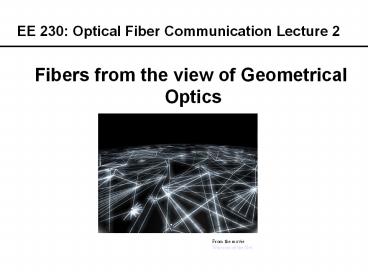EE 230: Optical Fiber Communication Lecture 2 - PowerPoint PPT Presentation
1 / 21
Title:
EE 230: Optical Fiber Communication Lecture 2
Description:
EE 230: Optical Fiber Communication Lecture 2 Fibers from the view of Geometrical Optics From the movie Warriors of the Net Total Internal Reflection Reflection as a ... – PowerPoint PPT presentation
Number of Views:272
Avg rating:3.0/5.0
Title: EE 230: Optical Fiber Communication Lecture 2
1
EE 230 Optical Fiber Communication Lecture 2
Fibers from the view of Geometrical Optics
From the movie Warriors of the Net
2
Total Internal Reflection
3
Reflection as a function of angle
This additional Phase Shift is not accounted for
in geometrical wave approach
The reflectivities of waves polarized parallel
and perpendicular to the plane of incidence as
given by the Fresnel equations
Fiber Optics Communication Technology-Mynbaev
Scheiner
4
Principal Types of Optical Fiber
- Types of Fibers
- Single mode/Multi-mode
- Step Index/Graded Index
- Dispersion Shifted/Non-dispersion shifted
- Silica/fluoride/Other materials
- Major Performance Concerns for Fibers
- Wavelength range
- Maximum Propagation Distance
- Maximum bitrate
- Crosstalk
Understanding Fiber Optics-Hecht
5
Fabrication of Optical Fiber
- Fabrication of fiber preform macroscopic
version with correct index profile - Drawing of preform down into thin fiber
- Jacketing and cabling
6
Step-Index Fiber
- Cladding typically pure silica
- Core doped with germanium to increase index
- Index difference referred to as delta in units
of percent (typically 0.3-1.0) - Tradeoff between coupling and bending losses
- Index discontinuity at core-clad boundary
7
Basic Step index Fiber Structure
Fiber Optics Communication Technology-Mynbaev
Scheiner
8
Ray Trajectories in Step Index fiber
Meridional Rays
Skew Rays
9
Coupling Light into an Optical Fiber
Fiber Optics Communication Technology-Mynbaev
Scheiner
10
Acceptance Angle
The acceptance angle (qi) is the largest incident
angle ray that can be coupled into a guided ray
within the fiber The Numerical Aperature (NA)
is the sin(qi) this is defined analagously to
that for a lens
Optics-Hecht Zajac
11
?2
?1
f2
f1
nCO
nCL
12
For Corning SMF-28 optical fiber
- nco1.4504, nCL1.4447 at 1550 nm
- NA 0.13
- Acceptance angle 7.35 degrees
13
Geometrical View of Modes
- Ray approximation valid in the limit that l goes
to zero - Geometrical Optics does not predict the existance
of discrete modes - Maxwells Equations and dielectric boundary
conditions give rise to the requirement that the
fields and phase reproduce themselves each
cycle
Fiber Optics Communication Technology-Mynbaev
Scheiner
14
Rays and Their E-field Distribution
15
Origin of Modal Dispersion
- Straight path along fiber axis has distance L and
velocity c/nCO for transit time of LnCO/c - Path at maximum acceptance angle fc has distance
L/cosf2 where f290º-?c and thus a longer transit
time. - Transit time difference equal to
- Dispersion limits rate of signals that fiber can
handle - If spread can be up to 70 of bit period, then
maximum bit rate is 1.4cnCO/(NA)2
16
Intermodal Dispersion
Fiber Optics Communication Technology-Mynbaev
Scheiner
17
Bandwidth for Various Fiber Types
No intermodal time shift for single Mode Fiber
Fiber Optics Communication Technology-Mynbaev
Scheiner
18
Graded Index Fiber
Fiber Optic Communication Systems-Agarwal
Fiber Optic Communications-Palais
19
Ray Propagation in Graded-Index Fiber
Graded Index Slab Uniform in X and Z
Fundamentals of Photonics - Saleh and Teich
20
Ray spreading comparison
21
Comparison, continued
- If NA0.13 and nCO1.45,
- ?tSI/L19 ps/m
- ?tGI/L0.039 ps/m
- Graded-index fiber has substantially less modal
dispersion































